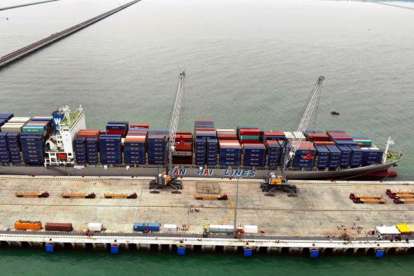Bisnis.com, JAKARTA – PT Pelabuhan Indonesia I (Persero) recorded significant performance growth in Kuala Tanjung Port,Batu Bara Regency, North Sumatra. The flow of goods in Kuala Tanjung port rose by more than 30 percent as of August 2020.
Pelindo 1 President Director Dani Rusli Utama said the current performance of goods was supported by ship visits at Kuala Tanjung Multipurpose Terminal which reached 169 calls or there were 4 to 5 calls per week.
“The positive growth of Kuala Tanjung Port supported by its large capacity will attract investors building the industry,” he said, Thursday (9/24/2020).
In addition, the realization of container loading and unloading at KTMT until August 2020 is 30,309 boxes. The realization of container loading and unloading until August 2020 grew 32.5 percent from the realization in 2019 of 22,870 boxes.
If in TEUs, the container loading and unloading realization until August 2020 is 31,956 TEUs. This realization is up 34 percent from the achievement of container unloading in 2019 by 23,937 TEUs.
The increase in throughput also occurs in the loading and unloading of liquid bulk and general cargo. The realization of liquid bulk loading and unloading at KTMT until August 2020 reached 242,596 Tons for CPO commodities and their derivatives. Realization up to August grew 137 percent from 102,200 tons in 2019.
The realization of general cargo loading and unloading until August 2020 amounted to 46,801 Tons, up 176 percent from the achievement of realization in 2019 which reached 16,970 Tons.
According to him, Kuala Tanjung Port is supported by sei mangkei hinterland and Special Economic Area (KEK) so that the industry in Kuala Tanjung starts to develop which then impacts on positive traffic growth.
Dani Rusli explained that the essence of the construction of a port is the ecosystem, so all seek to accelerate other industries into kuala tanjung area and Kuala Tanjung industrial area.
“Pelindo 1 is optimistic that Kuala Tanjung Port will be the future of Indonesia. The port has good facilities, a draft of 16-17 meters LWS (Low Water Spring) so that it can serve ships weighing 50,000 DWT (dead weight tonnage), and growth has started well,” he said.


